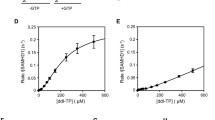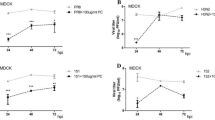Summary
Acyclic nucleoside phosphonates are potent antiviral agents effective against replication of DNA viruses and retroviruses including human immunodeficiency virus (HIV). In addition to their antimetabolic mode of antiviral action, acyclic nucleoside phosphonates also possess immunomodulatory properties. We have shown recently that a number of them stimulate secretion of cytokines including chemokines RANTES/CCL5 (“regulated upon activation, normal T cell expressed and secreted”) and MIP-1 alpha/CCL3 (macrophage inflammatory protein-1 alpha) that may inhibit entry of HIV in cells. In present experiments we analyzed effects of acyclic nucleoside phosphonates on gene expression of other members of the beta family of chemokines, monocyte chemotactic proteins (MCPs), which have also been implicated in the control of HIV infection. The following compounds differing at the type of heterocyclic base, i.e. adenine (A), or 2,6-diaminopurine (DAP), at the 6-amino group of the base, and at the N 9-side chain represented by 9-[2-(phosphonomethoxy)ethyl] (PME) and 9-[2-(phosphonomethoxy)propyl] (PMP) moieties were included in the study: (1) (R)-PMPA, ie. tenofovir, (2) N 6-cyclopropyl-(R)-PMPDAP, (3) N 6-cyclopentyl-(R)-PMPDAP, (4) N 6-dimethylaminoethyl-(R)-PMPDAP, (5) N 6-cyclopentyl-PMEDAP, (6) N 6-isobutyl-PMEDAP, (7) N 6 -cyclohexylmetyl-PMEDAP, and (8) N 6 -cyclooctyl-PMEDAP. These compounds are able to activate production of MCP-1 and MCP-3, and none of them influences gene expression of MCP-2, and MCP-5. Enhancement of monocyte chemotactic protein expression was found to be mediated by transcriptional factor nuclear factor-κB (NF-κB).
Similar content being viewed by others
Explore related subjects
Discover the latest articles and news from researchers in related subjects, suggested using machine learning.References
De Clercq E. 2004. HIV-chemotherapy and prophylaxis: new drugs, leads and approaches. Int. J. Biochem. Cell Biol. 36: 1800–1822
Kramata P., Votruba I., Otová B., Holý A. 1996. Different inhibitory potencies of acyclic phosphonomethoxyalkyl nucleotide analogs toward DNA polymerases a, d and e. Mol. Pharmacol. 49: 1005–1011
Crowe S. 1999. New reverse transcriptase inhibitors. Adv. Exp. Med. Biol. 458: 183–197
Holý A., Votruba I., Merta A., Černý J., Veselý J., Vlach J., Sediva K. 1990 Acyclic nucleotide analogues: synthesis, antiviral activity and inhibitory effects on some cellular and virus-encoded enzymes in vitro. Antiviral Res. 13: 295–311
Zídek Z., Potměšil P., Kmoníčková E., Holý A. 2003. Immunobiological activity of N-[2 phosphonomethoxy)alkyl] derivatives of N 6 -substituted adenines, and 2,6-diaminopurines. Eur. J. Pharmacol. 475: 149–159
Zídek Z., Franková D., Holý A. 2001. Activation by 9-(R)-[2-(phosphonomethoxy)propyl]adenine of chemokine (RANTES, macrophage inflammatory protein-1 alpha) and cytokine (tumor necrosis factor alpha, interleukin-10 [IL-10], IL-1 b) production. Antimicrob. Agents Chemother. 45: 3381–3386
Loetscher P., Seitz M., Clark-Lewis I., Baggiolini M., Moser B. 1994. Monocyte chemoattractant proteins MCP-1, MCP-2 and MCP-3 are major attractants for human CD4+ and CD8+ T lymphocytes. FASEB 8: 1055–1060
Van Coillie E., Van Damme J., Opdenakker G. 1999. The MCP/eotaxin subfamily of CC chemokines. Cytokine Growth Factor Rev. 10: 61–86
Bacon K., Baggiolini M., Broxmeyer H., Horuk R., Lindley I., Mantovani A., Maysushima K., Murphy P., Nomiyama H., Oppenheim J. 2002. Chemokine/chemokine receptor nomenclature. J. Interferon Cytokine Res. 22: 1067–8
Holý A., Votruba I., Tloušťová E., Masojídková M. 2001. Synthesis and cytostatic activity of N-[2-(phosphonomethoxy)alkyl] derivatives of N6-substituted adenines, 2,6-diaminopurines and related compounds. Collect. Czechoslovak. Chem. Commun. 66: 1545–1592
Chen Z., Yu S., Bakhiet M., Winblad B., Zhu J. 2003. The chemokine receptor CCR5 is not necessary inflammatory mediator in kainic acid induced hippocampal injury: evidence for a compensatory effect by increased CCR2 and CCR3. J. Neurochem. 86: 61–68
Hu J., Li G., Wang W., Zhu J., Li Y., Zhou G., Sun Q. 2002. Transfection of colorectal cancer cells with chemokine MCP-3 (monocyte chemotactic protein-3) gene retards tumor growth and inhibits tumor metastasis. World J. Gastroenterol. 8: 1067–1072
Park M., Hoffmann K., Cheever A., Amichay D., Wynn T., Farber J. 2001. Patterns of chemokine expression in models of Schistosoma mansoni inflammation and infection reveal relationships between type 1 and type 2 responses and chemokines in vivo. Infect. Immun. 69: 6755–6768
Schreck R., Meier B., Mannel D., Droge W., Baeuerle P. 1992. Dithiocarbamates as potent inhibitors of nuclear factor kappa B activation in intact cells. J. Exp. Med. 175: 1181–1194
Frade J., Llorente M., Mellado M., Alcami J., Gutierrez-Ramos J., Zaballos A., Real G., Martinez C. 1997. The amino-terminal domain of the CCR2 chemokine receptor acts as coreceptor for HIV-1 infection. J. Clin. Invest. 100: 497–502
Blanpain C., Migeotte I., Lee B., Vakili J., Doranz B., Govaerts C., Vassart G., Doms R., Parmentier M. 1999. CCR5 binds multiple CC-chemokines: MCP-3 acts as natural antagonist. Blood 94: 1899–1905
Vicenzi E., Alfano M., Ghezzi S., Gatti A., Veglia F., Lazzarin A., Sozzani S., Mantovani A., Poli G. 2000. Divergent regulation of HIV-1 replication in PBMC of infected individuals by CC chemokines: suppression by RANTES, MIP-1a and MCP-3, and enhancement by MCP-1. J. Leukoc. Biol. 68: 405–412
Gonzalez E., Rovin B., Sen L., Cooke G., Dhanda R., Mummidi S., Kulkarni H. 2002. HIV-1 infection and AIDS dementia are influenced by a mutant MCP-1 allele linked to increased monocyte infiltration of tissues and MCP-1 levels. Proc. Natl. Acad. Sci. USA 99: 13795–13800
Eugenin E., D`Aversa T., Lopez L., Calderon T., Berman J. 2003. MCP-1 (CCL2) protects human neurons and astrocytes from NMDA or HIV-tat-induced apoptosis. J. Neurochem. 85: 1299–1311
Hokeness K., Kuziel W., Biron C., Salazar-Mather T. 2005. Monocyte chemoattractant protein-1 and CCR2 interactions are required for IFN-alpha/beta-induced inflammatory response and antiviral defense in liver. J. Immunol. 174: 1549–1556
Hirose K., Hakozaki M., Nyunoya Y., Kobayashi Y., Matsushita K., Takenouchi T., Mikata A. 1995. Chemokine gene transfection into tumour cells reduced tumorigenicity in nude mice in association with neutrophilic infiltration. Br. J. Cancer 72: 708–714
Rollins B., Sunday M. 1991. Suppression of tumor formation in vivo by expression of the JE gene in malignant cells. Mol. Cell Biol. 11: 3125–3131
Mantovani A., Bottazzi B., Sozzani S., Peri G., Allavena P., Dong Q., Vecchi A., Colota F. 1993. Cytokine regulation of tumour-associated macrophages. Res. Immunol. 144: 280–283
Sarafi M., Garcia-Zepeda E., MacLean J., Charo I., Luster A. 1997. Murine monocyte chemoattractant protein (MCP)-5: a novel CC chemokine that is structural and functional homologue of human MCP-1. J. Exp. Med. 185: 99–109
Gong W., Howard O., Turpin J., Grimm M., Ueda H., Gray P., Raport C., Oppenheim J., Wang J. 1998. Monocyte chemotactic protein-2 activates CCR5 and blocks CD4/CCR5-mediated HIV-1 entry replication. J. Biol. Chem. 273: 4289–4292
Berger E., Murphy P., Farber J. 1999. Chemokine receptors as HIV-1 coreceptors: roles in viral entry, tropism and disease. Annu. Rev. Immunol. 17: 657–700
Schols D., Proost P., Damme J., De Clercq E. 1997. RANTES and MCP-3 inhibit the replication of T-cell-tropic human immunodeficiency virus type 1 strains (SF-2, MN, and HE). J. Virol. 74: 7300–7304
Modi W., Goedert J., Strathdee S., Buchbinder S., Detels R., Donfield S., O`Brien S., Winkler C. 2003. MCP-1-MCP-3-Eotaxin gene cluster influences HIV-1 transmission. AIDS 17: 2357–2365
Chada S., Ramesh R., Mhashilkar A. 2003. Cytokine- and chemokine-based gene therapy for cancer. Curr. Opin. Mol. Ther. 5: 463–474
Wetzel K., Menten P., Opdenakker G., Van Damme J., Grone H., Giese N., Vecchi A., Sozzani S., Cornelis J., Rommelaere J., Dinsart C. 2001. Transduction of human MCP-3 by a parvoviral vector induces leukocyte infiltration and reduces growth of human cervical carcinoma cell xenografts. J. Gene Med. 3: 326–337
Fioretti F., Fradelizi D., Stoppacciaro A., Ramponi S., Ruco L., Minty A., Sozzani S., Garlanda C., Vecchi A., Mantovani A. 1998. Reduced tumorigenicity and augmented leukocyte infiltration after monocyte chemotactic protein-3 (MCP-3) gene transfer: perivascular accumulation of dendritic cells in peritumoral tissue and neutrophil recruitment within the tumor. J. Immunol. 161: 342–346
Pahl H.L. 1999. Activators and target genes of Rel/NF-kappaB transcription factors. Oncogene 18: 6853–6866
Li X., Massa P.E., Hanidu A., Peet G.W., Aro P., Savitt A., Mische S., Li J., Marcu K.B. 2002. IKKalpha , IKKbeta and NEMO/IKKgamma are each required for the NF-kappa B mediated inflammatory response program. J. Biol. Chem. 277: 45129–45140
Potmesil P., Krecmerova M., Kmonickova E., Holy A., Zidek Z. 2006. Nucleotide analogues with immunobiological properties: 9-[2-Hydroxy-3-(phosphonomethoxy)propyl]-adenine (HPMPA), -2,6-diaminopurine (HPMPDAP), and their N(6)-substituted derivatives. Eur. J. Pharmacol. 540: 191–199
Wuyts W., Vanaudenaerde B., Dupont L., Demedts M., Verleden G. 2003. Involvement of p38 MAPK, p42/p44 and NF kappa B in IL-1beta induced chemokine release in human airway smooth muscle cells. Respir. Med. 97: 811–817
Acknowledgements
The work was supported by grant no. 1M 6138896301 from the Centre for New Antivirals and Antineoplastics. It was performed as a part of research projects of the Institute of Experimental Medicine no. AV0 Z50390512 and the Institute of Organic Chemistry and Biochemistry no. Z40550506.
Author information
Authors and Affiliations
Corresponding author
Rights and permissions
About this article
Cite this article
Potměšil, P., Holý, A., Kmoníčková, E. et al. Acyclic nucleoside phosphonate antivirals activate gene expression of monocyte chemotactic protein 1 and 3. J Biomed Sci 14, 59–66 (2007). https://doi.org/10.1007/s11373-006-9116-4
Received:
Accepted:
Published:
Issue Date:
DOI: https://doi.org/10.1007/s11373-006-9116-4




